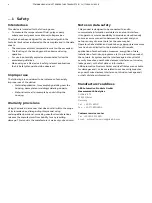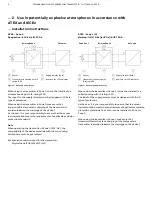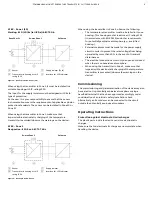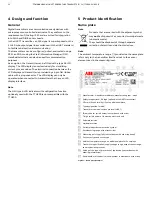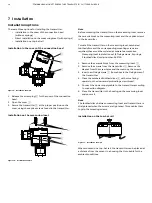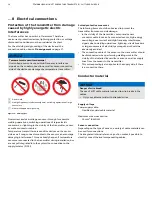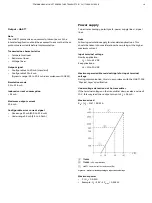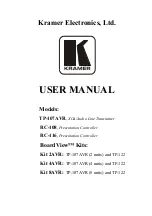
TTH200
HEAD-MOUNT TEMPERATURE TRANSMITTER | OI/TTH200-EN REV. B
7
LCD indicator
Intrinsic safety type of protection Ex ia IIC
Supply circuit
Max. voltage
U
i
= 9 V
Short-circuit current
I
i
= 65.2 mA
Max. power
P
i
= 101 mW
Internal inductance
L
i
= 0 mH
Internal capacitance
C
i
= 0 nF
Installation instructions
ATEX / IECEx
The installation, commissioning, maintenance and repair of
devices in potentially explosive atmospheres must only be
carried out by appropriately trained personnel. Works may be
carried out only by persons, whose training has included
instructions on different types of protection and installation
techniques, concerned rules and regulations as well as general
principles of zoning. The person must possess the relevant
expertise for the type of works to be executed.
When operating with combustible dusts, EN 60079-31 must be
complied with.
The safety instructions for electrical apparatus in potentially
explosive areas must be complied with, in accordance with the
directive 2014/34/EU (ATEX) and e.g. IEC 60079-14 (Installation
of equipment in potentially explosive atmospheres).
To ensure safe operation, the respectively applicable
requirements must be met for the protection of workers.
IP protection rating of housing
The temperature transmitter and LCD display type AS must be
installed such that the IP rating of at least IP20 is achieved in
accordance with IEC 60529.
Electrical connections
Grounding
If, for functional reasons, the intrinsically safe circuit needs to be
grounded by means of a connection to the potential
equalization, it may only be grounded at one point.
Intrinsic safety installation check
If transmitters are operated in an intrinsically safe circuit, proof
that the interconnection is intrinsically safe must be provided in
accordance with IEC/EN 60079-14 as well as IEC/EN 60079-25.
The supply isolators / DCS inputs must feature intrinsically safe
input protection circuits in order to eliminate hazards (spark
formation).
In order to provide proof of intrinsic safety, the electrical limit
value must be used as the basis for the EC-type examination
certificates for the equipment (devices); this includes the
capacitance and inductance values of the cables.
Proof of intrinsic safety is said to have been provided if the
following conditions are fulfilled when a comparison is carried
out in relation to the limit values of the equipment:
Transmitter
(intrinsically safe equipment)
Supply isolator / DCS input
(related equipment)
U
i
≥
U
o
I
i
≥
I
o
P
i
≥
P
o
L
i
+ L
c
(cable)
≤
L
o
C
i
+ C
c
(cable)
≤
C
o
Field (Ex area)
Control room (safe area)
A
Transmitter
B
Supply isolator / DCS input with
supply / Segment coupler
Figure 1: Intrinsic safety installation check
Installation in a potentially explosive atmosphere
Transmitters can be installed in all kinds of industrial sectors.
Potentially explosive systems are divided into zones,
meaning that a wide range of different instruments are also
required. For this, pay attention to the country-specific
guidelines and certificates!
Note
Ex relevant specifications must be taken from the EC-type
examination certificates and other relevant certificates that
apply in each case.




